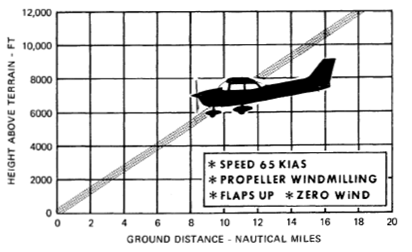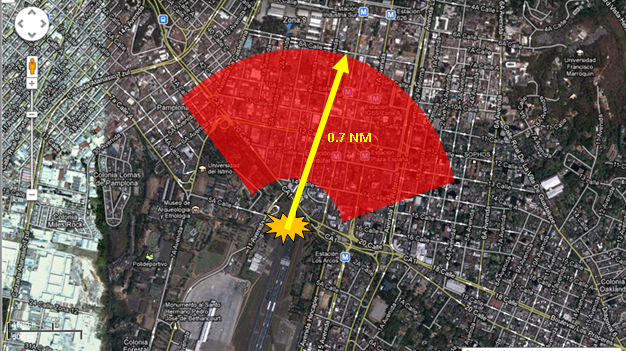Imagine… You are taking off and just when you reach the end of the runway your engine stops. Probably one of the worst emergencies. Suddenly your training kicks in… “Fly the plane / Look for landing area” …
Hang on right there, should you really start to look for an emergency landing area right then. I would rather determine the emergency landing area for my home airport ahead of time. This could save crucial seconds in an emergency situation. My home airport currently is La Aurora International Airport (MGGT) and emergency landing options are rare… here are some thoughts around this topic.
To calculate the glide range, the altitude has to be calculated. This can be done with the help of ground roll and climb rate. Knowing at what point the plane left the ground and at what rate it climbed will tell at what altitude the plane is at the end of the runway. The ground roll can be determined by the takeoff distance chart. All charts are taken from a classic Cessna 172.
La Aurora airport is at 4952 ft altitude. Using 30º Celsius is pretty pessimistic, but possible. Runway length 9,800 ft—Ground roll 1,500 ft = 8,300 ft.
 If climbing the length of the runway 8,300 ft at 70 knots, which equals 1.366 NM at 70 knots, the climb takes 1.17 minutes climb. After this time at 400 FPM the plane will be at 468 ft AGL. It is not recommended to try to turn around with at least 1000 feet AGL (it’s not called the Impossible Turn for no reason) and even then it might not be a good idea.
If climbing the length of the runway 8,300 ft at 70 knots, which equals 1.366 NM at 70 knots, the climb takes 1.17 minutes climb. After this time at 400 FPM the plane will be at 468 ft AGL. It is not recommended to try to turn around with at least 1000 feet AGL (it’s not called the Impossible Turn for no reason) and even then it might not be a good idea. At best glide angle the Cessna will glide approx. 6 NM from an altitude of 4000 ft or 1.5 NM for every 1000 ft of AGL. With the 468 ft of gained altitude the Cessna will glide 0.7 NM.
At best glide angle the Cessna will glide approx. 6 NM from an altitude of 4000 ft or 1.5 NM for every 1000 ft of AGL. With the 468 ft of gained altitude the Cessna will glide 0.7 NM.
As you can see from the above picture, there is not much emergency landing areas.
So what to do?
Some options to consider:
– Use 10° of flaps if recommanded for best angle of climb.
– Climb at best angle of climb Vx. The best angle of climb will provide the most altitude in the shortest distance. Keep as much runway under you as possible while climbing as high as possible.
– Request authorization to turn before the end of the runway at around 500 AGL. When arriving at the point where you would overshoot the runway, ask the tower for authorization for an early turn. There might be other options for emergency landing and, plus if part of the turn back to the runway is already done, the Impossible turn might become possible.
– Turn into the wind. This keeps you closer to the runway.
These are thoughts from a very green private pilot. Please don’t use any of this without your own judgement.
 |
Here some interesting reading about the impossible turn. |
What do you think? Let me know…


Hi,
I just wanted to let you know that I am impressed with your web page! It has a lot of useful information and it really looks nice and neat. I also like that it has information about the Aurora Airport, due to the fact that I am from Guatemala.
Keep it going.
Pingback: High Performance Takeoff from MGGT | Guatemala Skies